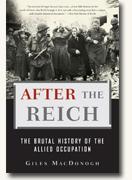After the Reich
Giles MacDonogh
book reviews:
· general fiction
· chick lit/romance
· sci-fi/fantasy
· graphic novels
· nonfiction
· audio books
· author interviews
· children's books @
curledupkids.com
· DVD reviews @
curledupdvd.com
newsletter
win books
buy online
links
home
for authors
& publishers
for reviewers

 |
After the Reich: The Brutal History of The Allied Occupation Giles MacDonogh Basic Books Paperback 656 pages February 2009 |
|
A lot has been written about World War II, and some has even been written about the aftermath regarding the development of the Cold War. However, there is not a lot of published information giving an overall view of the occupation of Germany and the development of the divided country that lasted for 40 years. After the Reich
However, After the Reich This makes the beginning of the book quite heavy. While MacDonogh obviously doesn’t go into details of individual rapes, the near-constant refrain about the rape and pillaging, both from individual accounts as well as statistical ones, wears on the reader. However, it also does get across just how horrible life in Germany and Austria was in the few months after the war ended. He also details the mass starvation as the populace lived on the bare minimum (and sometimes less) of sustenance. Hundreds of thousands died in this aftermath, and some thought “good riddance” to a population that they blamed for the war. This idea of “collective guilt” for the German populace is also examined by MacDonogh, where he presents figures from both sides of the controversy on whether the German civilians should be treated as a conquered people or as victims of the Nazi horror machine. It’s a running theme throughout as MacDonogh moves on to the administration of the four zones that Germany was divided into (Soviet, American, British and French). The effort to “de-Nazify” Germany was sometimes pursued heavily, with most of the populace seen as carrying some blame for what happened. On the other hand, this desire waned over the years as the objective became more to form a German democratic state to counter what the Soviets were turning their zone into. This is where After the Reich Even more interesting, before he gets to the politics of the situation, are his (sometimes brief) chapters on the return of culture to the various German zones and how this differed from one zone to another. The reader gets information on the return of theater, opera and classical music to German cities as they slowly started to rebuild from the vicious Allied bombing during the war. We see how civilians were learning to cope with the hardships brought on by occupation and resettlement, as millions of Germans were forcibly expelled from their homes to make room for land settlements with Czechoslovakia and Poland. MacDonogh ends After the Reich After the Reich After the Reich Originally published on Curled Up With A Good Book at www.curledup.com. © David Roy, 2007 |
| Also by Giles MacDonogh: |
|
|
|
 Click here to learn more about this month's sponsor! |
|
| fiction · sf/f · comic books · nonfiction · audio newsletter · free book contest · buy books online review index · links · · authors & publishers reviewers |
|
| site by ELBO Computing Resources, Inc. | |
 MacDonogh begins the book with the months leading up to the end of the war, as the Soviets were advancing through Poland and eastern Germany, raping and pillaging as much as possible. Revenge was a common motive, vengeance for every inhumane act the Nazis perpetrated on the Soviets during the almost four years of war. Others just gave in to their baser instincts. Heavily covered in this book, at the beginning and throughout, is how Austria figured into the whole issue. Many on both sides saw the Austrians as nearly as guilty as the Germans for what happened, yet it was always treated slightly differently. The fall of Vienna to the Soviets is the first chapter, and MacDonogh uses this as a stepping stone to detail just how horrible the Soviets treated everybody who lived behind the new front lines. Starvation as well as wanton rape were the main aspects of civilian life once the Soviets had passed.
MacDonogh begins the book with the months leading up to the end of the war, as the Soviets were advancing through Poland and eastern Germany, raping and pillaging as much as possible. Revenge was a common motive, vengeance for every inhumane act the Nazis perpetrated on the Soviets during the almost four years of war. Others just gave in to their baser instincts. Heavily covered in this book, at the beginning and throughout, is how Austria figured into the whole issue. Many on both sides saw the Austrians as nearly as guilty as the Germans for what happened, yet it was always treated slightly differently. The fall of Vienna to the Soviets is the first chapter, and MacDonogh uses this as a stepping stone to detail just how horrible the Soviets treated everybody who lived behind the new front lines. Starvation as well as wanton rape were the main aspects of civilian life once the Soviets had passed.